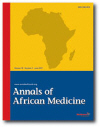
|
Annals of African Medicine
Annals of African Medicine Society
ISSN: 1596-3519
Vol. 4, No. 3, 2005, pp. 104-106
|
 Bioline Code: am05027
Bioline Code: am05027
Full paper language: English
Document type: Research Article
Document available free of charge
|
|
|
Annals of African Medicine, Vol. 4, No. 3, 2005, pp. 104-106
| en |
HIV Seropositivity in Children with Sickle Cell Disease
Ogunrinde, G. O.; Keshinro, M. I. & Ige, S. O.
Abstract
Background:
Blood transfusion forms an integral part of management of sickle cell disease. Blood transfusion is also established as a route of transmission of the Human Immunodeficiency Virus (HIV), especially in developing nations that are lacking in properly organized blood transfusion services.
Methods:
A retrospective study of randomly selected sickle cell anaemia patients screened for HIV antibodies in the paediatric haematology clinic of A.B.U.T.H., Zaria, Nigeria.
Results:
Twenty-nine (52.7%) males and 26 (47.3%) females were studied. Mean age (± 1 standard deviation) was 68.5 ±37.0 months. One (1.8%) of 55 patients was HIV-seropositive. The parents of this patient were HIV-seronegative. Twenty-five (45.5%) had positive history of blood transfusion and 22 (40.0%) had intramuscular injections outside the teaching hospital setting.
Conclusion:
The HIV-seropositive rate in this study is well below national estimates but highlights the continued risks of inadequate blood banking systems.
Keywords
HIV, positivity, children, sickle cell disease
|
| |
| fr |
Ogunrinde, G. O.; Keshinro, M. I. & Ige, S. O.
Résumé
Fond :
La transfusion sanguine fait partie intégrale du traitement de la drépanocytose. La transfusion sanguine est également établie comme voie de la transmission du virus d'immunodéficit humain (VIH), particulièrement dans les pays en voie de développement qui manquent les services de transfusion sanguine proprement organisés.
Méthode :
Une étude rétrospective des malades drépanocytose aléatoirement choisis et interviewés pour des anticorps de VIH dans la clinique pédiatrique de hématologie d'A.B.U.T.H., Zaria, Nigéria.
Résultats :
Vingt-neuf (52,7%) mâles et 26 (47,3%) femelles ont été étudiés. L'âge moyen (écart type de ± 1) était de 68,5 ±37,0 mois. Un (1,8%) de 55 malades était VIH-séropositif. Les parents de ces malades étaient VIH-séropositifs. Vingt-cinq (45,5%) ont eu l'histoire positive de la transfusion sanguine et 22 (40,0%) ont eu des injections intramusculaires à l'extérieur de l'hôpital d'enseignement.
Mots Clés
VIH, positivité, enfants, drépanocytose.
|
| |
© Copyright 2005 - Annals of African Medicine
Alternative site location: http://www.annalsafrmed.org
|
|
